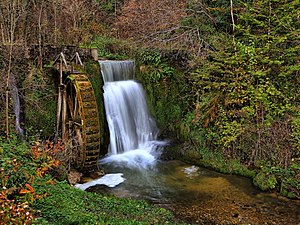Bretonvillers
| Bretonvillers | ||
|---|---|---|
|
|
||
| region | Bourgogne-Franche-Comté | |
| Department | Doubs | |
| Arrondissement | Pontarlier | |
| Canton | Valdahon | |
| Community association | Pays de Sancey-Belleherbe | |
| Coordinates | 47 ° 13 ' N , 6 ° 38' E | |
| height | 445-922 m | |
| surface | 13.66 km 2 | |
| Residents | 276 (January 1, 2017) | |
| Population density | 20 inhabitants / km 2 | |
| Post Code | 25380 | |
| INSEE code | 25095 | |
 Barrage at the former water mill |
||
Bretonvillers is a French municipality with 276 inhabitants (as of January 1 2017) in Doubs in the region Bourgogne Franche-Comté .
geography
Bretonvillers is 700 m above sea level, seven kilometers east of Pierrefontaine-les-Varans and about 35 kilometers south-southwest of the city of Montbéliard (as the crow flies). The village extends in the Jura , on a wide terrace high above the Dessoubre valley .
The area of the 13.66 km² large municipality covers a section of the French Jura. The central part of the area is taken up by the terrace of Bretonvillers, which is an average of 700 m. It is mainly made up of meadow and pasture land. East of the village begins the short but deeply cut erosion valley of a short side stream of the Dessoubre, which forms the eastern border. Towards the south the plateau descends with a steep slope to the Dessoubre valley about 250 m below. The slopes are dominated by limestone walls in various places. The municipal boundary mostly runs along the Dessoubre, which flows with a winding course to the east through a maximum 300 m wide, flat valley depression, and to the west along its tributary Reverotte . In the north, the terrain terrace is flanked by a wide ridge, which stretches from the Belmont north-east parallel to the Dessoubre valley to the Montaigu and separates the terrace of Bretonvillers from the western basin of Pierrefontaine. At 922 m, the highest point in Bretonvillers is reached on the northeastern roof of the Belmont.
In addition to the actual village, Bretonvillers also includes various hamlets and individual farms, namely:
- Le Saucet ( 700 m ) on the terrace above the confluence of the Reverotte and Dessoubre rivers
- Le Val ( 453 m ) in the deep valley of the Dessoubre
- La Joux ( 790 m ) on the ridge north of the ridge of La Racine
Neighboring municipalities of Bretonvillers are Chamesey in the north, Longevelle-lès-Russey and Rosureux in the east, Plaimbois-du-Miroir and Plaimbois-Vennes in the south and Pierrefontaine-les-Varans in the west.
history
Finds from the Mesolithic and Neolithic are evidence of a very early settlement of the municipality of Bretonvillers. In the Middle Ages, Bretonvillers belonged partly to the Vennes and partly to that of Belvoir. Together with Franche-Comté , the village came to France with the Peace of Nijmegen in 1678.
On January 1, 2009 there was a change in the arrondissement membership of the municipality. Previously belonging to the arrondissement of Montbéliard , all municipalities of the canton came to the arrondissement of Pontarlier.
Attractions
The Notre-Dame de la Nativité church was rebuilt in 1766; the bell tower dates from 1827. Other sights include the Saint-Joseph fountain and the Monument de la Vierge. Various farmhouses in the traditional Franche-Comté style from the 17th to 19th centuries have been preserved in the town center, the oldest dating from 1610. There is a chapel in the hamlet of Le Saucet.
population
| Population development | |
|---|---|
| year | Residents |
| 1962 | 379 |
| 1968 | 362 |
| 1975 | 308 |
| 1982 | 251 |
| 1990 | 236 |
| 1999 | 240 |
| 12016 | align = "center" | 276 | |
With 276 inhabitants (as of January 1, 2017), Bretonvillers is one of the small communities in the Doubs department. After the population in the first half of the 20th century had always been in the range between 380 and 470 people, a continuous population decline has been recorded since the beginning of the 1960s.
Economy and Infrastructure
Until well into the 20th century, Bretonvillers was mainly a village characterized by agriculture (cattle breeding and dairy farming, some arable and fruit growing). In addition, there are now some local small businesses, especially in wood processing and a polishing plant. Many workers are also commuters who work in the larger towns in the area.
The village is located away from the larger thoroughfares. Road links exist with Belleherbe, Longevelle-lès-Russey, Laviron and the road through the Dessoubre valley.
literature
- Le Patrimoine des Communes du Doubs. Volume 2, Flohic Editions, Paris 2001, ISBN 2-84234-087-6 , pp. 1194-1196.
